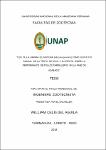Uso de la Harina de Mucuna (Mucuna pruriens) como sustituto parcial de la torta de soya y su efecto sobre la performance de pollos parrilleros en la fase de acabado
Abstract
El trabajo de investigación se llevó a cabo en el distrito y ciudad de Yurimaguas, provincia
de Alto Amazonas en el año 2016, con la finalidad de determinar el efecto del uso de la
harina de mucuna (Mucuna pruriens) como sustituto parcial de la torta de soya sobre
la performance de pollos parrilleros en la fase de acabado; se utilizaron 336 pollos Cobb de
21 días de edad. Los tratamientos fueron T0, T1, T2 y T3, con 0, 5, 10 y 15 % respectivamente
de inclusión de harina de mucuna y los parámetros evaluados fueron: consumo de alimento,
incremento de peso y conversión alimenticia, complementados con el rendimiento de
carcasa, mérito económico y prueba de degustación. Los resultados fueron analizados
estadísticamente mediante el Diseño Completamente al Azar (DCA), para contrastar los
tratamientos se utilizó la prueba de Duncan a un intervalo de confianza P<0.05.
Los resultados obtenidos fueron: consumo de alimento, T0: 2.92; T1=2.68; T2=2.56 y
T3=2.62 kg, con diferencia estadística (P<0.05) del testigo respecto a los demás
tratamientos, incremento de peso: T0=1.36; T1=1.28; T2=1.30 y T3=1.26 kg. sin diferencia
estadística, conversión alimenticia: T0=2.15; T1 = 2.09; T2=1.97 y T3=2.09, con diferencia
estadística significativa (P<0.05) del T2 con respecto al T0, rendimiento de carcasa: T0=
75.21; T1=74.42; T2=72.78 yT3=74.01%. El mayor mérito económico medido en soles
fue para el T2=1.75, seguidos de T0=1.73, T1=1.63 y T3=1.53. El orden de preferencia de
las carnes en la prueba de degustación fue: T0=57.1%, T1=28.6%, T3=14.3% y T2=0%.
Se concluye que la sustitución de la torta de soya por harina de mucuna remojada y tostada
no perjudica la performance de pollos parrilleros en la fase de acabado. Recomendando
el uso del 10% para este método de tratamiento. The research work was carried out in the district and city of Yurimaguas, province of Alto
Amazonas in 2016, with the purpose of determining the effect of the use of the mucuna flour (Mucuna pruriens) as a partial substitute for the cake of soybean on the performance of broiler chickens in the finishing phase; 336 Cobb chickens of 21 days of age were used. The treatments were T0, T1, T2 and T3, with 0, 5, 10 and 15% respectively of inclusion of
mucuna meal and the evaluated parameters were: food con-sumo, weight increase and feed conversion, complemented with the yield of carcass, economic merit and tasting test. The results were analyzed statistically by means of the Completely Randomized Design (DCA).
To test the treatments, the Duncan test was used at a confidence interval P <0.05.
The results obtained were: food consumption, T0: 2.92; T1 = 2.68; T2 = 2.56 and T3 = 2.62
kg, with statistical difference (P <0.05) of the control compared to the other treatments,
weight increase: T0 = 1.36; T1 = 1.28; T2 = 1.30 and T3 = 1.26 kg. no statistic difference,
feed conversion: T0 = 2.15; T1 = 2.09; T2 = 1.97 and T3 = 2.09, with statistically significa nt difference (P <0.05) of T2 with respect to T0, carcass yield: T0 = 75.21; T1 = 74.42; T2 =
72.78 and T3 = 74.01%. The greatest economic merit measured in soles was for T2 = 1.75, followed by T0 = 1.73, T1 = 1.63 and T3 = 1.53. The order of preference of the carves in the tasting test was: T0 = 57.1%, T1 = 28.6%, T3 = 14.3% and T2 = 0%.
It is concluded that the substitution of soya cake with soaked and roasted mucuna flour does not harm the performance of broiler chickens in the finishing phase. Recommend the use of 10% for this treatment method.
Collections
- Tesis [38]
The following license files are associated with this item:


